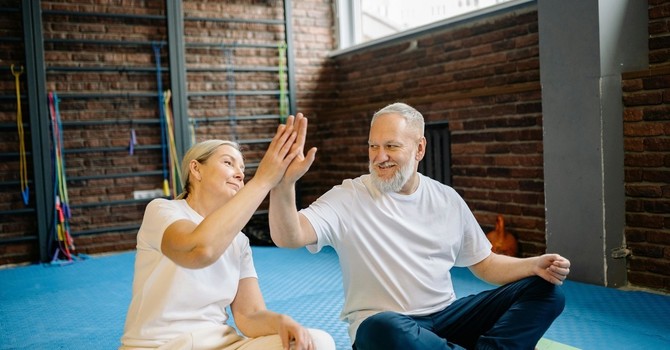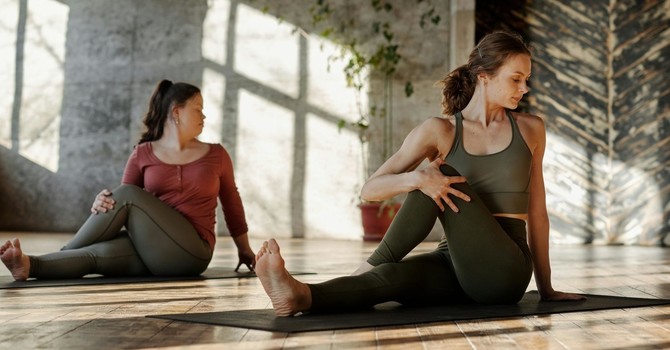
Most people are aware that exercise is a key to physical and emotional health. However, most people do not give exercise enough attention. Today, we’re going to discuss some of the specifics of a healthy exercise regimen. It is not realistic that everyone will become an elite athlete, but it is realistic that everyone can improve on what they are currently doing. If you’re just starting out, you’ll need to design a program that you can sustain. This is where beginners have the most questions. What should I do? How often? How intense should my workouts be? How long? Let’s dive into some of the basics so that you can come up with a safe and enjoyable program that works for you.
An ideal exercise program includes both resistance exercise for your muscles and aerobicexercise for your heart and lungs.
Aerobic exercise is brisk physical activity that requires the heart and lungs to work harder to meet the body’s increased oxygen demand. Aerobic exercise promotes circulation of oxygen through the blood. The American College of Sports Medicine (ACSM) defines aerobic exercise as “any activity that uses large muscle groups, can be maintained continuously, and is rhythmic in nature.” It is a type of exercise that challenges the heart and lungs- causing them to work harder than at rest. The most important idea behind aerobic exercise is to get up and get moving today!!
Aerobic Exercise Recommendations
- Exercises: Activity selection depends on several factors: Your current level of fitness, joint health, resources and interests. You should use a variety of exercise options to prevent overuse injuries and to maintain interest. Examples of aerobic exercise are bicycling, swimming, treadmills, eliptical exercisers, rowing machines and low-impact aerobics (i.e., walking, dance, or Tai Chi). Other options include basic activities such as walking the dog, mowing the lawn, and raking leaves. We recommend aquatic exercise as a good alternative for patients who cannot tolerate weightbearing exercises. This is an excellent option for patients with osteoarthritis and other degenerative conditions.
- Intensity: This is very subjective and is usually better addressed on an individual basis depending upon your health status. An easy starting tool is what is referred to as the “talk test” (whether an exerciser can converse comfortably during the activity without getting short of breath). If you are able to carry on a conversation, your exercise is light to moderate. If you are unable to carry a conversation, your exercise is considered vigorous. A more involved measurement is to workout at your target heart rate. This is calculated by maintaining between 50-75% of your maximuum heart rate. Your maximuum heart rate is 220 minus your age in years. The table below will help, but remember this is only a guideline. If you have heart disease or are on medication it may alter your heart rate and you should consult with your primary physician before beginning any exercise program.
Target Heart Rates
| Age | Target Heart Rate Zone 50-75% |
Average Maximum Heart Rate 100% |
| 20 years | 100-150 beats per minute | 200 |
| 25 years | 98-146 beats per minute | 195 |
| 30 years | 95-142 beats per minute | 190 |
| 35 years | 93-138 beats per minute | 185 |
| 40 years | 90-135 beats per minute | 180 |
| 45 years | 88-131 beats per minute | 175 |
| 50 years | 85-127 beats per minute | 170 |
| 55 years | 83-123 beats per minute | 165 |
| 60 years | 80-120 beats per minute | 160 |
| 65 years | 78-116 beats per minute | 155 |
| 70 years | 75-113 beats per minute | 150 |
- Volume: The recommended amount is generally 20-30 continous minutes per day. For those of you who think this is not feasible, you can start with shorter sessions spread out through the day and slowly increase up to the 20-30 minutes. Specific suggestions include such easy changes as taking a walk during lunch breaks and climbing the stairs instead of using the elevator.
- Frequency: You should perform aerobic exercise around 4-6 days per week.
- Progression: The progression of aerobic training intensity and volume should be gradual in nature- as with any exercise.
- Precautions: More often than not, injuries can be avoided if you gradually work up to the desired activity level and avoid excessive increases. Other precautions relate to your specific health risks and we would be glad to discuss this individually. However, remember there is always something each one of us can do to increase our aerobic activity without aggravating other conditions.
Resistance exercise should be performed 3-4 times per week. Beginners can start with elastic tubing and progress to machines or free weights. Tubing or free weights may be a better option for long-term programs as they may pose less of a chance for overuse injury compared with “one motion fits all” machines. Begin with light weights and progress slowly. A lifting program is not beneficial if you injure yourself by lifting heavy weights too soon. Lifting lighter weights for higher repetitions (12-20) will build strength and endurance. Lifting heavier weights for fewer repetitions (6-10) builds strength and bulk but also poses a greater chance for injury.
Make sure that your lifting program balances muscle groups. Lifters often focus on the large muscles that are more noticeable (i.e. chest and shoulders) and forget about the reciprocal muscle groups (i.e. scapular stabilizers). This leads to postural imbalance and an increased chance of injury. Many rotator cuff injuries result from this seemingly harmless imbalance. A good rule of thumb is to balance “pushers” with “pullers”. Pushers include; shoulders, chest, triceps, abs, quadriceps, and calves. Pullers include; biceps, back and posterior shoulder muscles and hamstrings. Pushers and pullers do not need to be worked during the same session; in fact they should probably be worked on different days.
While all this may all seem like a lot of work, the benefits of exercise will actually make your life a lot easier. Participating in physical fitness can help you more easily perform many of your day-to-day tasks. For example, being more flexible will help you do things like reaching into your cupboard and tying your shoes. Being stronger and having more balance will help you lift and carry items like groceries and will make it easier to get in and out of chairs and the bathtub. Improving your cardiorespiratory endurance will allow you to do things like climbing stairs, dancing, or playing with grandchildren without getting out of breath.
All are very good reasons to start exercising today! Just remember to make gradual changes to avoid injury and experiment with different activities until you find something that works for you.




